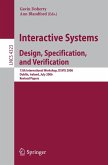The modern world has made available a wealth of new possibilities for interacting with computers, through advanced Web applications, while on the go with handheld smart telephones or using electronic tabletops or wall-sized displays. Developers of modern interactive systems face great problems: how to design applications which will work well with newly available technologies, and how to efficiently and correctly implement such designs. Design, Specification and Verification of Interactive Systems 2008 was the 15th of a series of annual workshops devoted to helping designers and implementers of interactive systems unleash the power of modern interaction devices and techniques. DSV-IS 2008 was held at Queen's University in Kingston, Canada, during July 16-18, 2008. This book collects the best papers submitted to the workshop. There were 17 full papers, 10 late-breaking and experience report papers, and two demonstrations. Keynote presentations were provided by Judy Brown of Carleton University and Randy Ellis of Queen's University. The first day of the workshop addressed the problems of user interface evaluation and specification, with particular emphasis on the use of task models to provide hi- level approaches for capturing the intended functionality of a user interface. Day two continued this theme, examining techniques for modeling user interfaces, particularly for mobile and ubiquitous applications. Presenters also discussed advanced implem- tation techniques for interactive systems. Finally, day three considered how to arc- tect interactive systems, and returned to the themes of evaluation and specification.
Bitte wählen Sie Ihr Anliegen aus.
Rechnungen
Retourenschein anfordern
Bestellstatus
Storno








